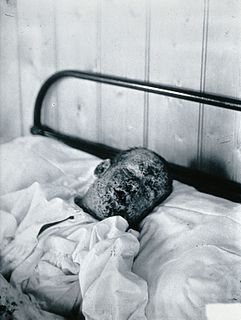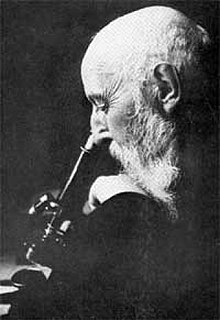Related Research Articles

Leprosy, also known as Hansen's disease (HD), is a long-term infection by the bacteria Mycobacterium leprae or Mycobacterium lepromatosis. Infection can lead to damage of the nerves, respiratory tract, skin, and eyes. This nerve damage may result in a lack of ability to feel pain, which can lead to the loss of parts of a person's extremities from repeated injuries or infection through unnoticed wounds. An infected person may also experience muscle weakness and poor eyesight. Leprosy symptoms may begin within one year, but, for some people, symptoms may take 20 years or more to occur.

Father Damien or Saint Damien of Molokai, SS.CC. or Saint Damien De Veuster, born Jozef De Veuster, was a Roman Catholic priest from Belgium and member of the Congregation of the Sacred Hearts of Jesus and Mary, a missionary religious institute. He was recognized for his ministry, which he led from 1873 until his death in 1889, in the Kingdom of Hawaiʻi for people with leprosy, who lived in government-mandated medical quarantine in a settlement on the Kalaupapa Peninsula of Molokaʻi.

A leper colony, also known by many other names, is an isolated community for the quarantining and treatment of lepers, people suffering from Hansen's disease. M. leprae, the bacterium responsible for leprosy, is believed to have spread from East Africa through the Middle East, Europe, and Asia by the 5th century before reaching the rest of the world more recently. Historically, leprosy was believed to be extremely contagious and divinely ordained, leading to enormous stigma against its sufferers. Other severe skin diseases were frequently conflated with leprosy and all such sufferers were kept away from the general public, although some religious orders provided medical care and treatment. Recent research has shown M. leprae has maintained a similarly virulent genome over at least the last thousand years, leaving it unclear which precise factors led to leprosy's near elimination in Europe by 1700. A growing number of cases following the first wave of European colonization, however, led to increased attention towards leprosy during the New Imperialism of the late 19th century. Following G.A. Hansen's discovery of the role of M. leprae in the disease, the First International Leprosy Conference held in Berlin in 1897 renewed interest and investment in the isolation of lepers throughout the European colonial empires. Although Western countries now generally treat cases of Hansen's disease individually on an outpatient basis, traditional isolated colonies continue to exist in India, China, and some other countries.
Lepra is a UK-based international charity established in 1924, working to diagnose, treat, and rehabilitate people with leprosy. Lepra currently works in India, Bangladesh and Zimbabwe.

Marianne Cope, also known as Saint Marianne of Molokaʻi, was a German-born American religious sister who was a member of the Sisters of St Francis of Syracuse, New York, and founding leader of its St. Joseph's Hospital in the city, among the first of 50 general hospitals in the country. Known also for her charitable works, in 1883 she relocated with six other sisters to Hawaiʻi to care for persons suffering leprosy on the island of Molokaʻi and aid in developing the medical infrastructure in Hawaiʻi. Despite direct contact with the patients over many years, Cope did not contract the disease.
Leprosy was said to be first recognized in the ancient civilizations of China, Egypt and India, according to the World Health Organization (WHO). Leprosy, also known as Hansen's disease, was officially eliminated at the national level in China by 1982, meaning prevalence is lower than 1 in 100,000. There are 3,510 active cases today. Though leprosy has been brought under control in general, the situation in some areas is worsening, according to China's Ministry of Health. In the past, leprosy sufferers were ostracized by their communities as the disease was incurable, disfiguring and wrongly thought to be highly infectious.
Mycobacterium lepraemurium is a causative agent of feline leprosy. It causes granulomatous lesions, characteristic of the Mycobacterium genus.

Eradication is the reduction of an infectious disease's prevalence in the global host population to zero.
William Jopling was an Italian-born British leprologist who together with D. S. Ridley proposed the Ridley-Jopling classification of leprosy (1962), and wrote the widely read textbook of "Handbook of Leprosy" which had a fifth edition. He had a wide understanding of leprosy problems based on his experiences as the director of Jordan hospital, a leprosy hospital (1950–1967) in England and wrote various articles including "leprosy stigma".
Leprosy stigma is a type of social stigma, a strong negative feeling towards a person with leprosy relating to their moral status in society. It is also referred to as leprosy-related stigma, leprostigma, and stigma of leprosy. Since ancient times leprosy instilled the practice of fear and avoidance in many societies because of the associated physical disfigurement and lack of understanding behind its cause. Because of the historical trauma the word "leprosy" invokes, the disease is now referred to as Hansen's disease, named after Gerhard Armauer Hansen who discovered Mycobacterium leprae, the bacterial agent that causes Hansen's disease. Those who have suffered from Hansen's disease describe the impact of social stigma as far worse than the physical manifestations despite it being only mildly contagious and pharmacologically curable. This sentiment is echoed by Weis and Ramakrishna, who noted that "the impact of the meaning of the disease may be a greater source of suffering than symptoms of the disease".

Jesus cleansing a leper is one of the miracles of Jesus. The story is found in all three of the Synoptic Gospels: Matthew 8:1–4, Mark 1:40–45 and Luke 5:12–16.

The Leprosy Mission is a Christian international NGO. They are the largest and oldest player in the fight against leprosy and are working towards the goal of zero leprosy transmission by 2035. Their vision is 'leprosy defeated, lives transformed'.
Leprosy currently affects approximately a quarter of a million people throughout the world, with the majority of these cases being reported from India.

Worldwide, two to three million people are estimated to be permanently disabled because of leprosy. India has the greatest number of cases, with Brazil second and Indonesia third.

The history of leprosy was traced to its origins by an international team of 22 geneticists using comparative genomics of the worldwide distribution of Mycobacterium leprae. Monot et al. (2005) determined that leprosy originated in East Africa or the Near East and traveled with humans along their migration routes, including those of trade in goods and slaves. The four strains of M. leprae are based in specific geographic regions where each predominantly occurs:

Buluba Hospital, whose formal name is St. Francis Hospital Buluba, is a community hospital in Uganda. It is owned and operated by the Roman Catholic Diocese of Jinja.

The 1321 lepers' plot was an alleged conspiracy of French lepers to spread their disease by contaminating water supplies, including well water, with their powders and poisons. According to the American historian Solomon Grayzel, lepers were the most abused group of people during the Middle Ages: they were thrown out of settlements and treated as wild animals due to the widespread belief that their disease was highly contagious. However, other historians have contested such a view, pointing out that lepers often lived within communities in leper houses (leprosaria) and were supported by charitable donations.
The COVID-19 pandemic in Vatican City is part of the ongoing worldwide pandemic of coronavirus disease 2019 caused by severe acute respiratory syndrome coronavirus 2. The Holy See reported the first case of infection in Vatican City on 7 March 2020. Unlike other jurisdictions that report cases within a given territory or cases of residents or citizens of a territory, the Holy See reports on cases "in Vatican City State and among the employees of the Holy See" regardless of location of testing, treatment, or residence. There were 29 confirmed cases of COVID-19 among the Vatican's residents and employees; there were no associated deaths. The 29 cases included 10 employees, 1 new hire, and 1 resident of Vatican City. All those infected tested negative by 6 June 2020. An outbreak among members of the Holy See's Swiss Guard was reported in mid-October, totaling 11 as of October 15.
Sister Mary de Lourdes Gogan was an Irish Medical Missionaries of Mary nun and missionary nurse in Nigeria.
Sister Mary Francis or Eileen Morris was an Irish Medical Missionaries of Mary nun and missionary nurse in Nigeria.
References
- ↑ McMenamin, Dorothy (2011). Leprosy and stigma in the South Pacific: a region-by-region history with first person accounts. Jefferson, N.C.: McFarland. p. 17. ISBN 978-0-7864-6323-7. Archived from the original on 2016-05-19.
- ↑ Mares, Courtney. "Pope Francis proclaims World Day for Grandparents and the Elderly". Catholic News Agency. Retrieved 2021-01-31.